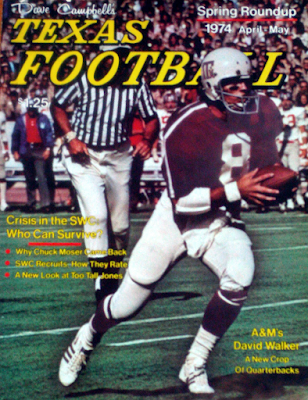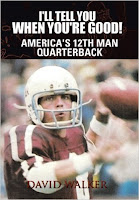Guest Blog Post by Dave Walker. He is the youngest player in the history of college football to start at quarterback for a major college team. Dave was a 17 year old Freshman when he played QB for Texas A&M in 1973. Dave is a resident of College Station Tx..and owns 12thManQB.com
As the new Kyle Field prepares for its grand opening, I'm reminded of what it took to arrive here. I think about all the sacrifices made by players throughout the years—sacrifices of which many Aggie fans may be unaware. There were endless practice hours, lengthy film sessions, grueling off-seasons, intense school work, and life-long injuries. There are the wonderful victories that satisfied the soul, along with the gut-wrenching defeats suffered in front of thousands of fans and replayed in our hearts and minds for decades.
I began my college career in 1973, a year after freshmen were allowed to play varsity football in the United States. I was a 17-year-old kid from Louisiana, an All-State MVP who'd de-committed from LSU and the SEC to head west to Texas. I'd never seen an A&M game in person and most certainly not on TV, not in those days. The Aggies were pretty down-on-their-luck for quite some time before my class arrived, having gone 48-100-6 in their previous 16 seasons. That's 3 wins per year! Those prior years included only one winning season, that of 1967 (7-4).
You can see the challenge we faced, but we were a confident bunch; we were a team that brought with it the original image of pure swagger.
Our group signaled the beginning of the modern era, as we not only had freshmen starting on varsity but also had tremendous black players being recruited to Texas A&M's football team for the first time. It didn't take long for the Aggies to become very good, and we were soon a major factor both in the Southwest Conference and on the national scene.
The first Aggie game I ever saw was against Wichita State on September 15, 1973. I went in as the backup quarterback and scored a touchdown, although it was called back because of a penalty. It was easily the largest crowd I'd ever played in front of, but less than half the 70,000 I would have been playing in front of at LSU.
You certainly always remember your first game. We played that Wichita State game in front of a crowd of just under 31,500 fans. At the time, Kyle Field could seat 48,000 or so, meaning a third of the stadium was empty for the season opener. Still, we won 48-0 and everyone had a lot of fun. We had some talent, young as it was.
By mid-season I was starting at QB and I'll never forget the tremendous announcer, C. K. Esten, drawling, "And in the Aggie backfield, Bean, Sams, Walker and Walker." Those were golden moments, although I must admit I rarely heard him. We lost two tough road games and barely missed getting a winning season.
In 1974 we had Texas A&M's second winning season in 17 years with our 8-3 record, followed by the first back-to-back 10-win seasons in school history. This feat has only been matched three times since.
The '75 team won its first 10 games and was ranked No. 2 in the country before falling to Arkansas and their "Wrecking Crew" defense coached by Jimmy Johnson. That's right; that was their moniker.
The 1976 team started a second 10-game winning streak that included A&M's first bowl win in 19 years (a 37-14 Sun Bowl victory over Florida), that carried over into the 1977 season. This is the only time Texas A&M has enjoyed two separate 10-game winning streaks in such a short span.
The '74, '75 and '76 defenses combined were the best in modern school history, surrendering an average of only 201 yards per game. The 1975 defense was the very best in the country, giving up 80 yards rushing and 183 total yards per game, records that still stand today at A&M.
We had first-team All-Americans in linebackers Ed Simonini, Garth Ten Napel and Robert Jackson, and defensive backs Pat Thomas and Lester Hayes. We were the "Mad Dog" defense, a stone wall of tremendous athletes assembled by coaching great Melvin "Mad Dog" Robertson. Future All-American defensive end Jacob Green would also spring from this mold.
Our other All-American was kicker Tony Franklin. Such was our offensive prowess in the mid-70's under Coordinator Tom Wilson, Tony remained Texas A&M's career leading scorer for 19 years after he'd finished college. The Wishbone of ours seemingly set new school records every outing, either in scoring, rushing or total offense. One rushing record still stands today after 38 years; 606 yards gained vs. TCU in 1977. I don't see that one being broken anytime soon. The other was 1977’s school record 300 yards rushing per game that lasted 13 years, and 38 years later still ranks second.
Bubba Bean's 94-yard scamper against Texas Tech stood as the longest in A&M history for 19 years. Darrell Smith's 90-yard carry vs. TCU in 1976 held second place for 17 years. Our 1976 team, that of the A&M Centennial, was the first to win a game against Texas in Austin in 20 years, and was ranked third in the country by The Sporting News by season's end.
My Southwest Conference single-game QB rushing record of 182 yards established in a comeback win over SMU at Kyle Field will never be erased, although 35 years later Johnny Manziel set the new school record in our Cotton Bowl win over OU. Kudos to Johnny Football.
After finishing school as a four-year starter, I left as the all-time winningest quarterback at Texas A&M, a spot I held for 18 years. I've been no worse than second-winningest for 38 years. This isn't said to pat myself on the back, but as a representation of the outstanding people I played with at A&M in the mid-70's. I played quarterback in 42 of 46 games for the Ags and while it was brutal at times, we all knew that the legacy we were building would long be carried forward, as it has been up to this triumphant day that lies ahead for the 12th Man, Kyle Field and all Aggie teams of the future.
This will be my 43rd season as an Aggie, and I have never experienced such a feeling of despair and hopelessness as was present before we arrived in College Station. Our 1974 squad permanently set A&M on its winning course, and is the foundation for establishing winning as a real tradition for the first time. The following few years insured that Aggie winning tradition, and from those humble times we've never looked back.
When we played inside Kyle Field we were a lock, losing only once in '74, '75 and '76. Our hope is the new Kyle Field enjoys equal or even better success. I have many great memories of Kyle Field, mixed among them the historic game against Tommy Kramer and Rice in 1976. We managed a 57-34 victory over the Owls that day, weathering 60 passes thrown by that season's All-American quarterback, and set the all-time combined scoring record for an SWC game in so doing.
In 1977 we followed with an 8-4 season, attaining for the first time in A&M history 36 victories over a four-year period, all against 1-A competition. All told, from 1974 through 1977, we were nationally ranked in 43 of our 47 games, unheard of in the history of Aggie football.
The four games in which we were unranked happened to be in 1976, when we got on that powerhouse roll that was very similar to 2012's and finished 7th in the final A.P. poll. It's a historically overlooked season, for some reason, that returned the third-highest ranking of any A&M team since 1940. (The '40 team was ranked 6th and Bear Bryant's 1956 team was ranked 5th.)
And we accomplished all this with a couple of hot tubs, a small training room, two dressing rooms, a small meeting room, and a weight room that had a couple of benches and a few mirrors, and was there for all 16,000 students and faculty to use. Still, we sent 30 players into the NFL and had another 40 who were named 1st-team All-SWC. Not bad for a group of no-frills players.
My final home game vs. Texas in 1977 drew 57,443 fans; remarkable, considering we were still playing in a 48,000 seat stadium. And remember, when I saw my first game, Kyle Field was only two-thirds full. It’s called growing by leaps and bounds, symbolizing us and our players’ contribution.
This era was the beginning of a tremendous history for Texas A&M University, the 12th Man, and Kyle Field, itself. Kyle Field may be the House that Johnny built, but by the time our “whole new breed of cat” football teams were done, a 50% addition in seating was planned and soon completed that increased Kyle Field's capacity from 48,000 to 72,000 by 1982. We'd brought big time football, big time donors, and national TV cameras to Kyle Field, and it blossomed from there.
This is our history: the Wishbone and the Mad Dog Defense. We were ultra-slick and powerful on all fronts. Our era provided the explosion of excitement that has grown into the frenzy we see today. It just wasn't documented with social media, pictures, videos, interviews, ESPN and the like. But, boy, did it happen!
This place in time goes lost and forgotten in all the hullabaloo that exists now, and that's certainly understandable. It's ironic though, that this is the 40-year anniversary of the greatest defense ever to step onto the turf at Kyle Field, just as a new Kyle Field era begins. Forty years ago A&M saw the greatest athletes who had ever worn the Maroon and White take the field. The '75 team would be ranked as high as No. 2 after 10 contests, only the fifth team in Aggie football history to reach this lofty of a perch.
Three of those teams were of course Homer Norton's '39 champions, followed by rankings as high as No. 2 during the '40 and '41 seasons. The other team ranked second or higher was Bear Bryant and John David Crow's 1957 team, a team that was ranked No. 1 with two games to play, and lost both. Then they lost their bowl game. These were the Junction Boys. Somewhere between them, the Wrecking Crew, and the 102,000-seat-present, lie the players who were tabbed Bellard’s Bunch—seemingly lost in Aggie football lore.
The builders of the castle remember, though, and we're all still out here, observing. We know how you got here, Aggies, and we are incredibly proud! Gig 'em!




